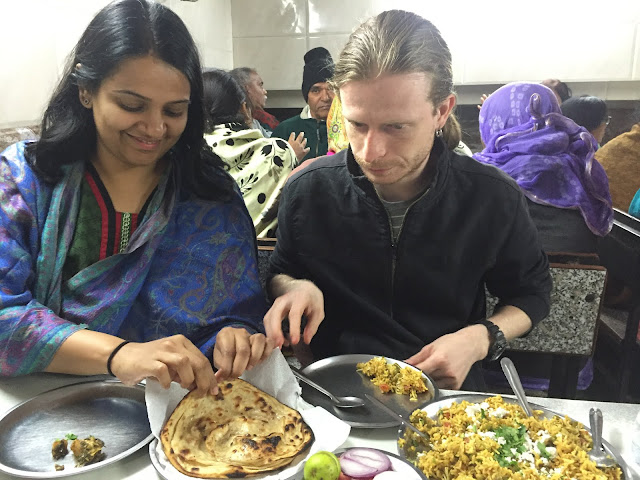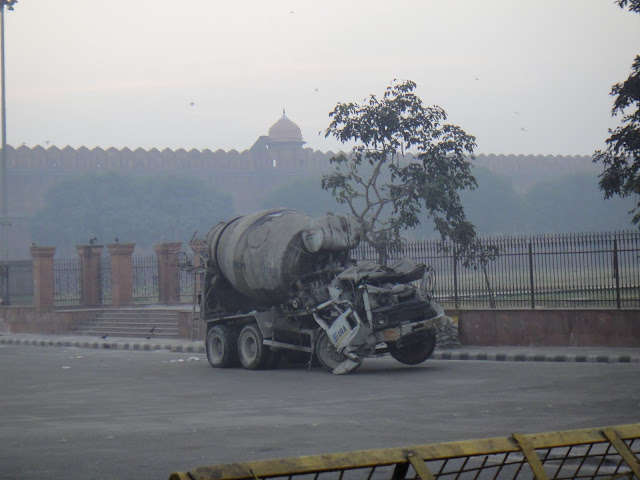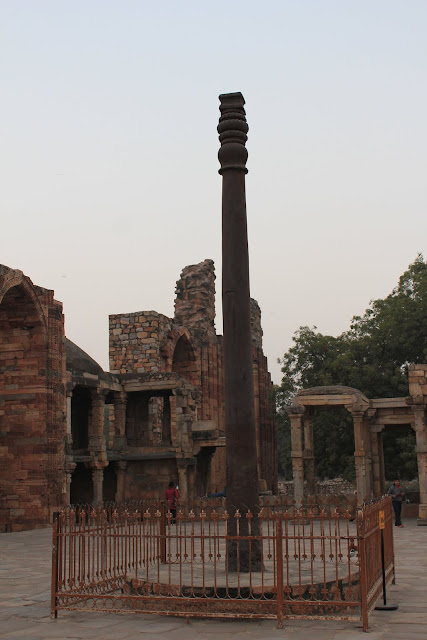Our first destination was the Mahatma Gandhi Museum, which houses a substantial collection of Gandhi artifacts and writings. More pictures can be seen on
Flickr. We were impressed by the focus in his writings on gender equity, and also learned about the industrial exploitation of India by the British Empire that we hadn't really been clear about before. I figured there would have been exploitative resource extraction (mining etc.) but the efforts to dismantle and forbid additional Indian industrial infrastructure so that India would be dependent on imports from Britain was something I hadn't understood. Ana knew a surprising amount because a lot of it was textile-based.
The portable spinning wheel and other tools made it really, really hard for the British Empire to forbid domestic production of fiber and cloth. Apparently Gandhi was a big fan of this form of civil disobedience.
Most signage presented in Hindi and English
Unfortunately, the museum could clearly use more money and more skilled curators. The place was largely deserted and it was clear it wasn't scrupulously taken care of. Artifacts were not always appropriately protected or in situations that would prevent their long-term deterioration. One thing to mention about foreign tourism in India - international tourist tickets into attractions tend to run at about 10x the cost of tickets for Indian citizens. I am perfectly fine with this as I think the most expensive tickets we ever paid for were about $5. I just hope the money makes it back into supporting and preserving the historic items and architecture we went to see.
After the museum we went to Mahatma Gandhi's memorial and resting place. It was a big park with iffy landscaping, but the open space and green things made the air feel cleaner and that was nice.


If you had a limited amount of time in New Dehli, it might not be the end of the world to miss this one. The museum has all the information and context, if that's what you're after.
Third, we went to Humayun's Tomb. For more information on who he was than 'an emperor of most of India' I would recommend checking out
Wikipedia's entry. Our pictures on
Flickr are better than theirs, though. This was the first place where we experienced the apparent excitement of Indian children in seeing foreigners - we attracted a lot of attention from touring school groups just going up to the ticket counter.
I found the architecture really pretty striking, even with some parts of the site in disrepair and the canals not exactly flowing strongly everywhere. This was also the first site where we thought, man, I'd really have loved to see this when it was new. Fortunately, there is evidence of substantial investment and improvement at this site - hopefully they follow through and bring it back to its full impact. I believe they are adding a new museum as well, which would be great.

Entryway / construction site for the new museum
We teased our friend of Indian descent pretty unmercifully for not knowing her way around all these places she'd never been before.
Dump in the park over the wall from a World Heritage site - see a lot of this kind of thing
Shut up, photography is important
Quite a mausoleum - and the closer you get the more intricate the detail work becomes.
I'm not sure the pictures do justice to the scale of it.
Painting on one part of the ceiling of the inside.
If you like elaborate things carved out of single pieces of stone, India has definitely got you covered.
After all this touristing, we were getting pretty hungry and went to a fancy restaurant called Petals recommended by the driver. Our friends were pretty stunned by the prices, which were reasonable for the US, meaning extremely expensive for India. However, it was one of the very best meals we had in India, so I personally can't complain. It was sort of modern/international fusion done with Indian dishes, and their take on tandoori chicken was so good I mentally committed to buying a tandoor at some point and attempting to duplicate the recipe. I need more of that chicken.

Note the bottled water - you don't EVER drink from the tap or eat anything that may have touched tap water in India if you are a foreigner and value your time. Purdue's international travel vaccinations and prep nurse was exceptionally clear on this. We were in possession of powerful antibiotics in case we screwed that up, along with other less drastic measures for more minor stomach/gastrointestinal upsets. Some places do boil or filter their water, but can you trust that no mistakes were made?
Yeah, that chicken there. It isn't normal. It is amazing. Those onions and some of the other raw stuff here and elsewhere looked great, super fresh, smelled increasingly tantalizing as time without raw food started adding up. We didn't eat any of it. I wish I could have, here and elsewhere, but the risk was not worth the reward.
Our last tourist destination of the day was the
Qutb Minar, which is basically a big damn tower erected by a Muslim ruler of the area 800 years ago (!) out of pieces taken from several dozen temples that had previously been on the site destroyed on his order. Our guide for this one (if you don't have one, prospective guides will not leave you alone - most of ours were vetted ahead of time by our local travel agency for quality) provided a lot of information we definitely would not have gotten from the limited to non-existent signage. Apparently you could go up it until just recently when the inevitable someone doing something incredibly stupid in/off of a priceless monument happened. Now it is locked and you can only see it from the ground.
I really recommend looking at pictures at full size here or on Flickr to see the detail - it is really something. Wikipedia says some of the writing relates details about the construction of the tower, along with passages from the Qur'an.
Guides can also be helpful for taking group photos
The grounds around the Qutb Minar also used to house a university open to Hindu and Muslim students. We think universities are generally good ideas.
Again, would have loved to see these when they were new. Even broken ruins have astonishingly intricate and detailed work done at huge scale.
As engineers, the
Iron Pillar was a satisfying curiosity - I'm not 100% on whether the rustproof iron was made deliberately or by accident - but it may be up to around 1600 years old and it doesn't rust due to high phosphorus content in the metal.
After the Qutb closed (we got chased out by security a little bit), we were definitely ready for dinner. Our friends talked to the driver and wrested a lower-cost-but-good dining option out of him. It was related to us that if the foreigners get sick, the drivers are supposed to report it to the government and they bear some sort of responsibility or consequences for bringing foreigners to a place where they got sick. This proved to be an ongoing problem - it was very difficult to get recommendations for places not specifically catering to foreigners - but you also don't want to just walk into places that aren't clean and get super sick either. Places targeting foreigners tend to be expensive and bland, but relatively safe. In this case, we got a recommendation from the driver for a something at the level of a diner near the hotel. The front desk also endorsed it, so off we went.
It proved to be a real find and ten times less expensive than the lunch place. I think it came out to about $3.50 for the four of us for dinner. We did get some looks when we walked in.
The raw veggies looked amazing again, definitely didn't eat them this time either. The cashew chicken with cheese was delicious, and we'd pay more for worse versions of it in the future. I don't recall what that green dish was exactly except that it was quite spicy.

They don't mess around putting ghee on the naan and roti. Eventually got tired of that, but at this point it was still delicious. It is difficult to avoid everything raw - not the cilantro on the rice dish. We figured it had already touched the food and ate it, without severe consequences. This diner was also one of my favorite places that we went. Undeniably cheap and among the best places we ate.



























































